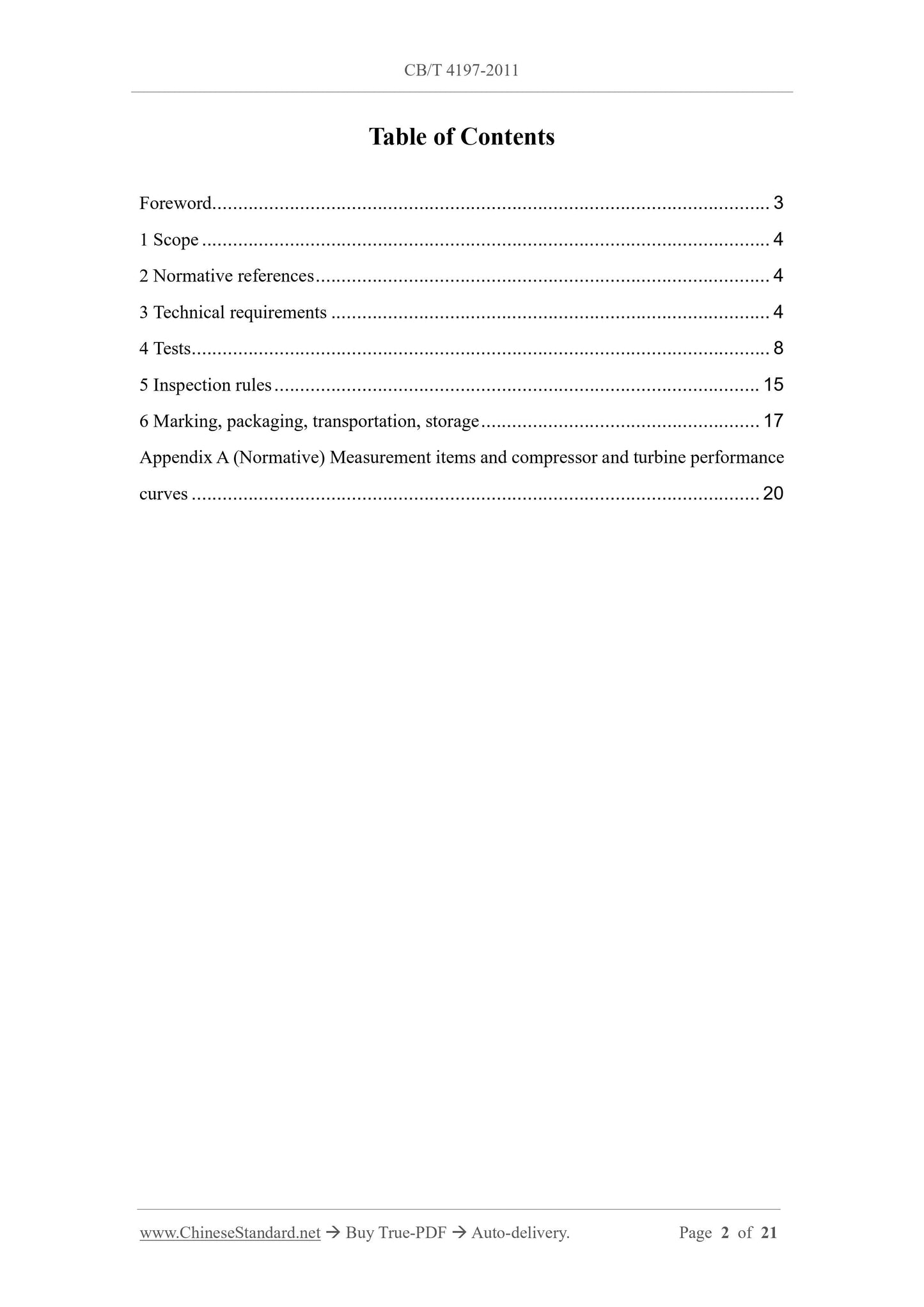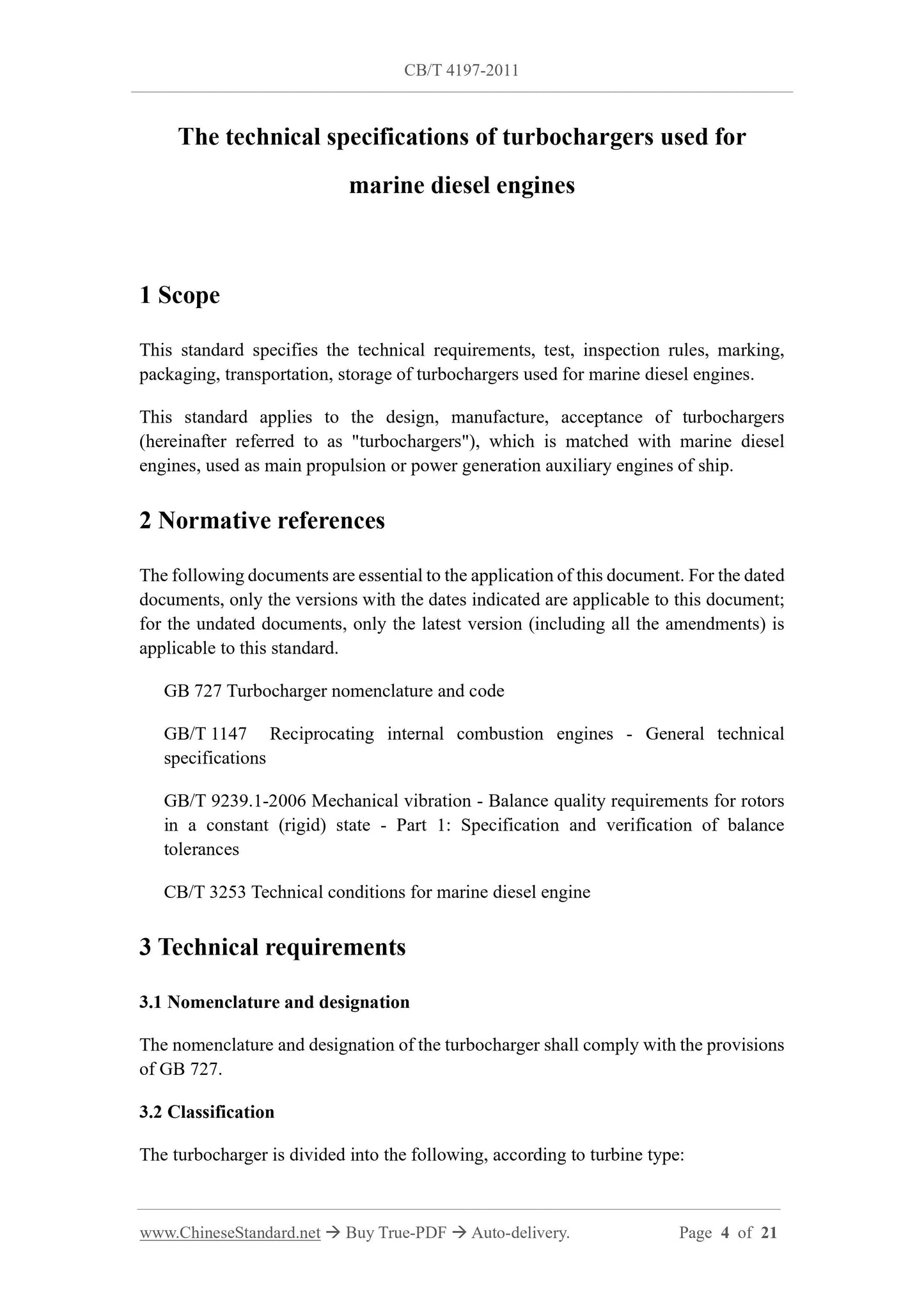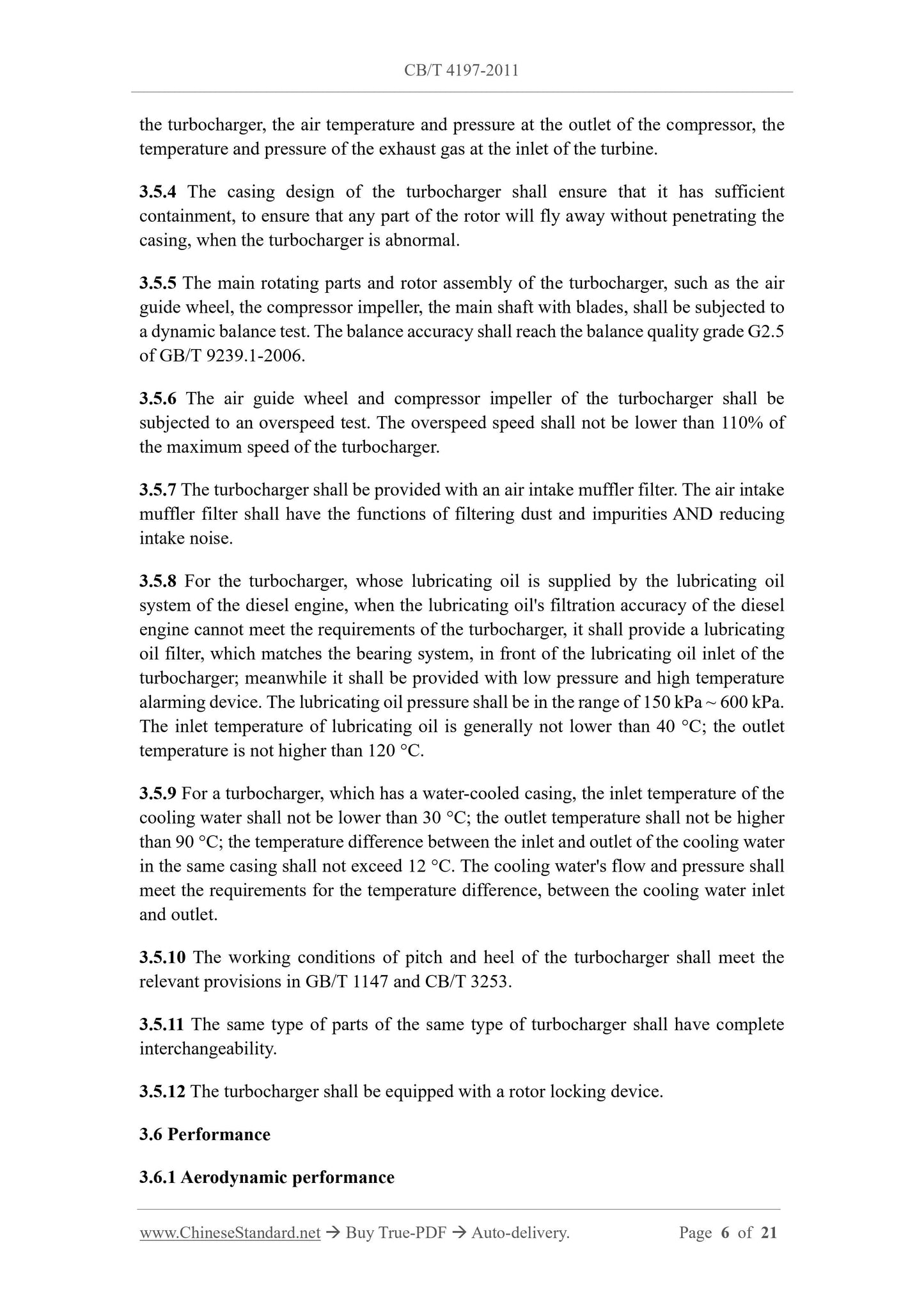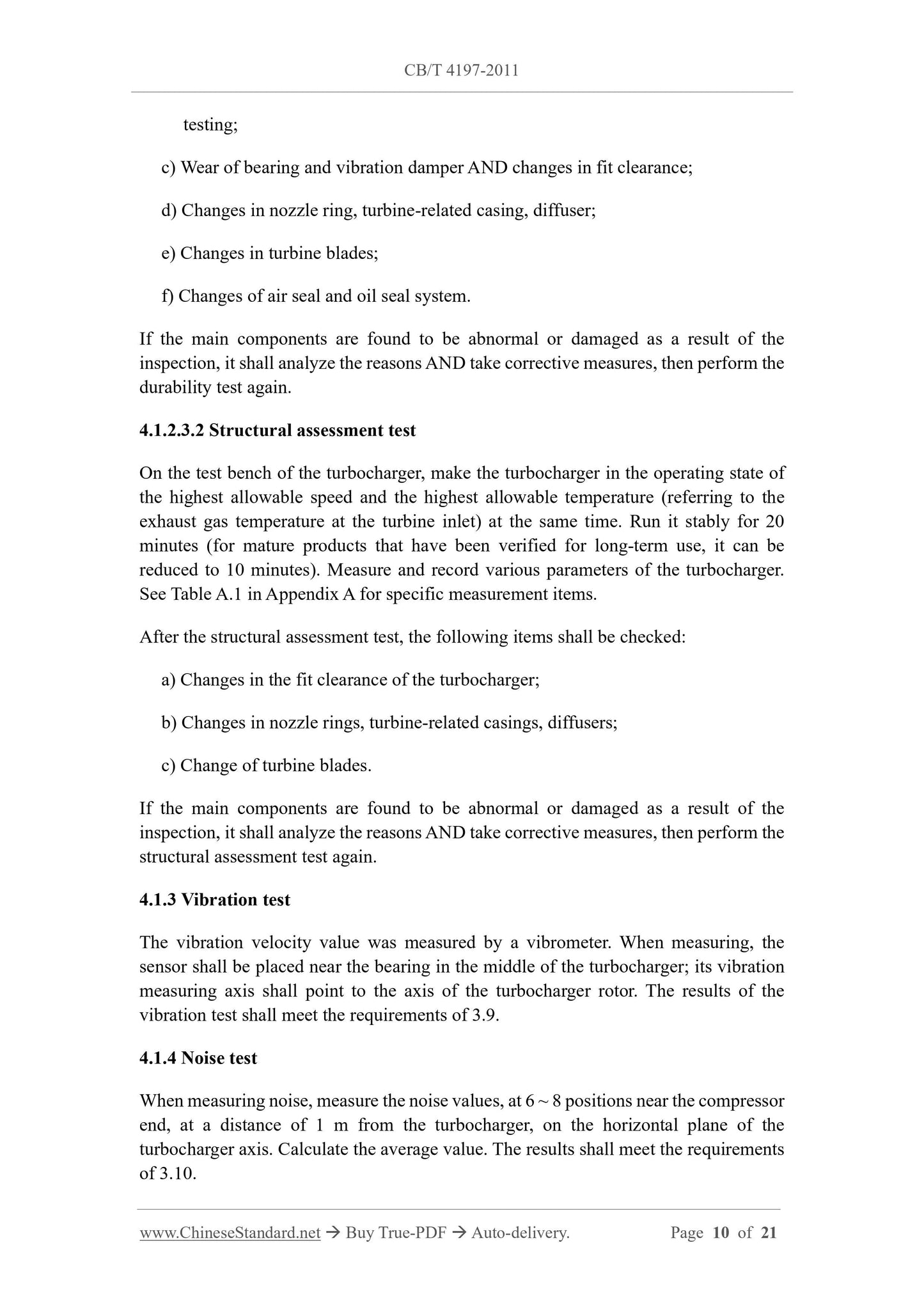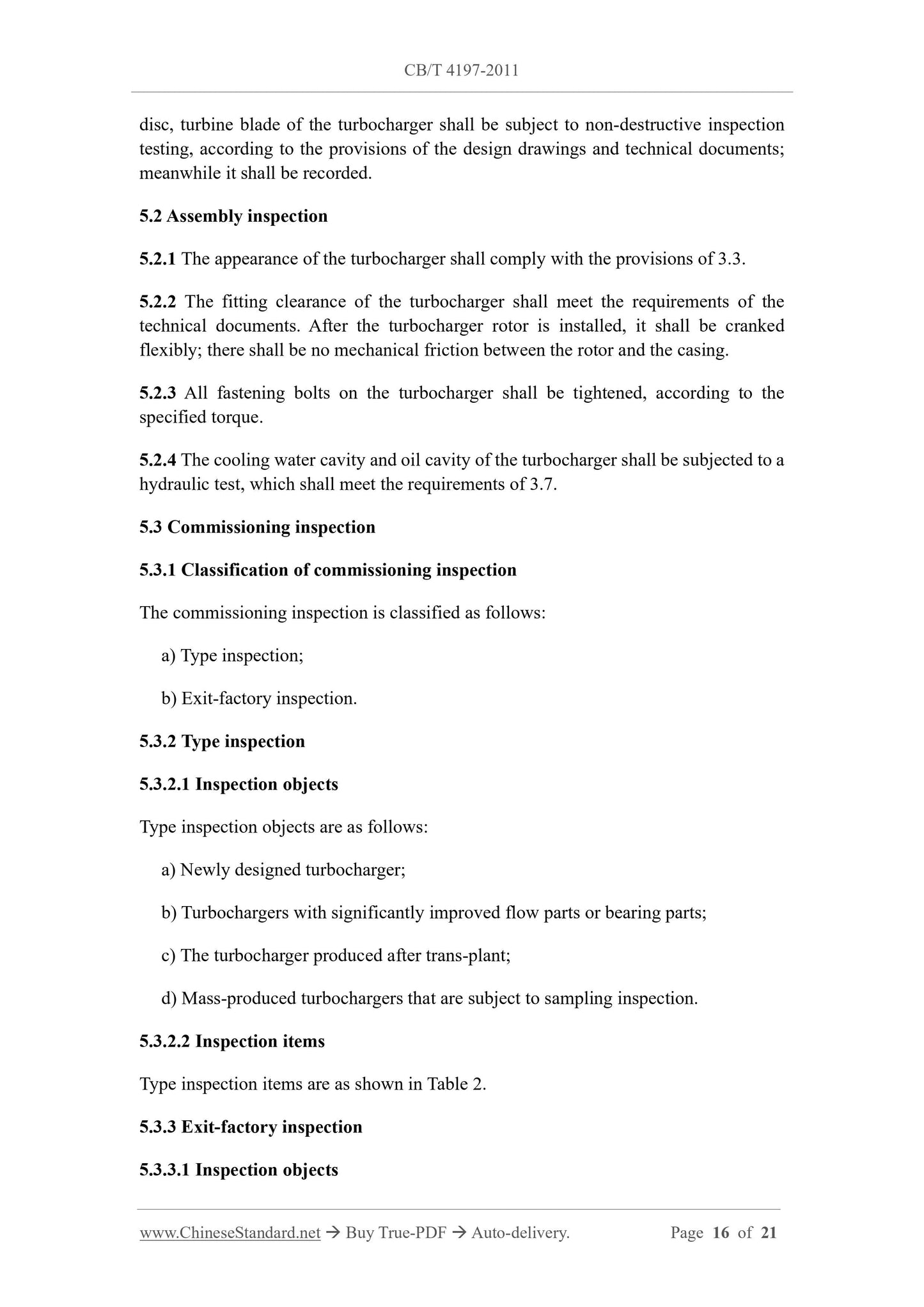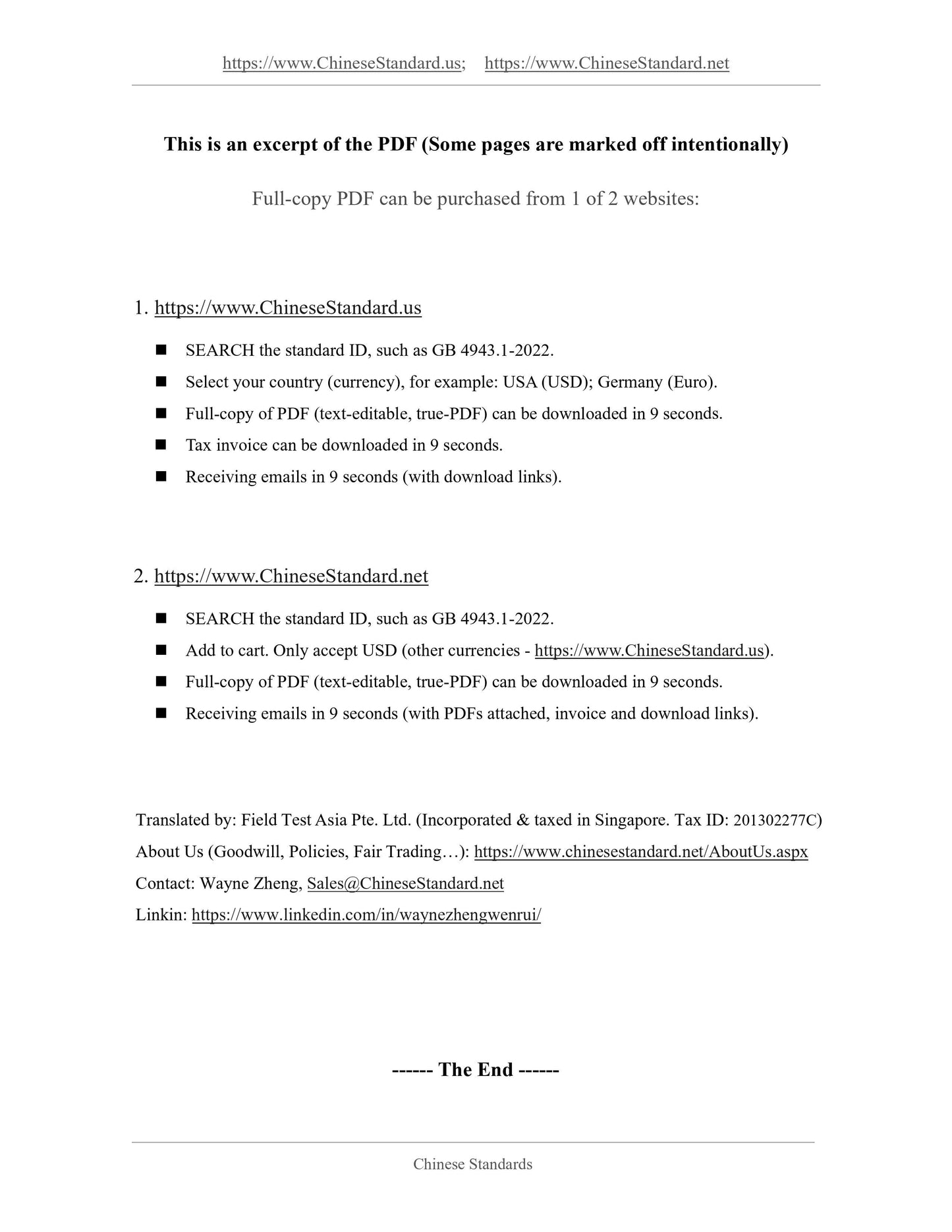1
/
von
10
PayPal, credit cards. Download editable-PDF and invoice in 1 second!
CB/T 4197-2011 English PDF (CBT4197-2011)
CB/T 4197-2011 English PDF (CBT4197-2011)
Normaler Preis
$220.00 USD
Normaler Preis
Verkaufspreis
$220.00 USD
Grundpreis
/
pro
Verfügbarkeit für Abholungen konnte nicht geladen werden
Delivery: 2 working-hours manually (Sales@ChineseStandard.net)
Need delivered in 3-second? USA-Site: CB/T 4197-2011
Get Quotation: Click CB/T 4197-2011 (Self-service in 1-minute)
Historical versions (Master-website): CB/T 4197-2011
Preview True-PDF (Reload/Scroll-down if blank)
CB/T 4197-2011: The technical specifications of turbochargers used for marine diesel engines
CB/T 4197-2011
MARINE INDUSTRY STANDARD OF
THE PEOPLE?€?S REPUBLIC OF CHINA
ICS 47.020.20
U 44
Filing No.: 32906-2011
The technical specifications of turbochargers used for
marine diesel engines
ISSUED ON: JUNE 15, 2011
IMPLEMENTED ON: OCTOBER 01, 2011
Issued by: Ministry of Industry and Information Technology of PRC
Table of Contents
Foreword ... 3??
1 Scope ... 4??
2 Normative references ... 4??
3 Technical requirements ... 4??
4 Tests ... 8??
5 Inspection rules ... 15??
6 Marking, packaging, transportation, storage ... 17??
Appendix A (Normative) Measurement items and compressor and turbine performance
curves ... 20??
The technical specifications of turbochargers used for
marine diesel engines
1 Scope
This standard specifies the technical requirements, test, inspection rules, marking,
packaging, transportation, storage of turbochargers used for marine diesel engines.
This standard applies to the design, manufacture, acceptance of turbochargers
(hereinafter referred to as "turbochargers"), which is matched with marine diesel
engines, used as main propulsion or power generation auxiliary engines of ship.
2 Normative references
The following documents are essential to the application of this document. For the dated
documents, only the versions with the dates indicated are applicable to this document;
for the undated documents, only the latest version (including all the amendments) is
applicable to this standard.
GB 727 Turbocharger nomenclature and code
GB/T 1147 Reciprocating internal combustion engines - General technical
specifications
GB/T 9239.1-2006 Mechanical vibration - Balance quality requirements for rotors
in a constant (rigid) state - Part 1: Specification and verification of balance
tolerances
CB/T 3253 Technical conditions for marine diesel engine
3 Technical requirements
3.1 Nomenclature and designation
The nomenclature and designation of the turbocharger shall comply with the provisions
of GB 727.
3.2 Classification
The turbocharger is divided into the following, according to turbine type:
the turbocharger, the air temperature and pressure at the outlet of the compressor, the
temperature and pressure of the exhaust gas at the inlet of the turbine.
3.5.4 The casing design of the turbocharger shall ensure that it has sufficient
containment, to ensure that any part of the rotor will fly away without penetrating the
casing, when the turbocharger is abnormal.
3.5.5 The main rotating parts and rotor assembly of the turbocharger, such as the air
guide wheel, the compressor impeller, the main shaft with blades, shall be subjected to
a dynamic balance test. The balance accuracy shall reach the balance quality grade G2.5
of GB/T 9239.1-2006.
3.5.6 The air guide wheel and compressor impeller of the turbocharger shall be
subjected to an overspeed test. The overspeed speed shall not be lower than 110% of
the maximum speed of the turbocharger.
3.5.7 The turbocharger shall be provided with an air intake muffler filter. The air intake
muffler filter shall have the functions of filtering dust and impurities AND reducing
intake noise.
3.5.8 For the turbocharger, whose lubricating oil is supplied by the lubricating oil
system of the diesel engine, when the lubricating oil's filtration accuracy of the diesel
engine cannot meet the requirements of the turbocharger, it shall provide a lubricating
oil filter, which matches the bearing system, in front of the lubricating oil inlet of the
turbocharger; meanwhile it shall be provided with low pressure and high temperature
alarming device. The lubricating oil pressure shall be in the range of 150 kPa ~ 600 kPa.
The inlet temperature of lubricating oil is generally not lower than 40 ??C; the outlet
temperature is not higher than 120 ??C.
3.5.9 For a turbocharger, which has a water-cooled casing, the inlet temperature of the
cooling water shall not be lower than 30 ??C; the outlet temperature shall not be higher
than 90 ??C; the temperature difference between the inlet and outlet of the cooling water
in the same casing shall not exceed 12 ??C. The cooling water's flow and pressure shall
meet the requirements for the temperature difference, between the cooling water inlet
and outlet.
3.5.10 The working conditions of pitch and heel of the turbocharger shall meet the
relevant provisions in GB/T 1147 and CB/T 3253.
3.5.11 The same type of parts of the same type of turbocharger shall have complete
interchangeability.
3.5.12 The turbocharger shall be equipped with a rotor locking device.
3.6 Performance
3.6.1 Aerodynamic performance
The total efficiency of the turbocharger, flow rate, compressor's pressure ratio,
compressor efficiency, turbine efficiency shall reach the design indicators. Under the
specified pressure ratio, the maximum deviation of the speed shall not exceed ??2%; the
maximum deviation of the flow shall not exceed ??3%.
3.6.2 Reliability
The turbocharger, that is normally used according to the maintenance and operation
instructions, shall be able to operate safely and stably, under its calibrated maximum
allowable speed and maximum allowable temperature (referring to the exhaust gas
temperature at turbine inlet). This calibration value corresponds to the 110% load
condition of the matched diesel engine AND has a certain margin.
3.7 Leaks
The cooling water cavity and oil cavity of the turbocharger shall be subjected to a
hydraulic test. The test pressure shall be 500 kPa or 1.5 times the working pressure
(whichever is greater), which lasts for 5 minutes. There shall be no leakage. When the
turbocharger is running, there shall be no water leakage, oil leakage, air leakage in the
casing and each seal.
3.8 Environmental adaptability
The design, test, parameter calculation of the turbocharger are based on the following
standard environmental conditions:
a) Ambient temperature t0 = 25 ??C;
b) Atmospheric pressure p0 = 100 kPa;
c) Relative humidity ??0 = 60%.
3.9 Vibration
When the turbocharger is running stably at each speed, the maximum allowable
vibration velocity of the axial-flow turbocharger is 4 mm/s. When the radial-flow and
mixed-flow turbochargers use a water-cooled casing, the allowable maximum vibration
velocity is 6 mm/s. When using a non-water-cooled casing, the maximum allowable
vibration velocity value is 4 mm/s.
3.10 Noise
During the platform test, the average value of the noise of the turbocharger (tested with
a muffler filter, sound pressure level) shall meet the requirements of Table 1.
The turbine performance test shall be carried out, on the turbine performance test bench.
When the conditions are not available, the turbocharger can also be operated in the self-
circulating condition, on the turbocharger test bench. Based on the measured parameters,
use the thermodynamic method to calculate the turbine performance parameters directly.
The specific measurement items are as shown in A.1 in Appendix A. After the test, the
expansion ratio-turbine efficiency curve and the expansion ratio-flow capacity curve
shall be made, according to the calculation results, as shown in A.3 in Appendix A.
The results of the turbine performance test shall meet the requirements of 3.6.1.
4.1.2.2.3 Performance test of the whole machine
The performance test of the whole machine is carried out on the turbocharger whole
machine test bench. During the test, the turbocharger runs to a specified pressure ratio,
in a self-circulating mode. After the working conditions are stable, measure and record
the various parameters of the turbocharger. The specific measurement items are as
shown in Table A.1 in Appendix A. Calculate the compressor pressure ratio, efficiency,
total turbocharger efficiency.
The results of the performance test of the whole machine shall meet the requirements
of 3.6.1.
4.1.2.3 Reliability test
4.1.2.3.1 Durability test
The durability test is carried out on the test bench of the turbocharger. The running time
of the turbocharger, in the durability test, is 50 h ~ 100 h, which shall include at least 1
h operation limit assessment, that is, the turbocharger is in the operating state of the
highest allowable speed and the highest allowable temperature (referring to the turbine's
inlet exhaust gas temperature). In other time periods of the durability test, the speed of
the turbocharger shall be 90% of the maximum allowable speed, the inlet exhaust gas
temperature of turbocharger can be lower than the maximum allowable temperature
(referring to the turbine's inlet exhaust gas temperature), by 30 ??C ~ 50 ??C. In the
durability test, after the working conditions are stable, it shall measure and record the
parameters of the turbocharger every 2 hours. For the specific measurement items, see
A.1 in Appendix A. In the durability test, the turbocharger itself is not allowed to fail.
If it is shutdown, which is caused by the suspension of test, due to reasons other than
the turbocharger, it shall not exceed two shutdowns in the entire durability test process;
the shutdown duration shall not exceed 1 h each time. The shutdown time shall not be
included in the durability test time.
After the durability test, the following items shall be checked:
a) Changes in the assembly clearance of the turbocharger;
b) Recheck the dynamic balance of the rotor assembly; carry out non-destructive
testing;
c) Wear of bearing and vibration damper AND changes in fit clearance;
d) Changes in nozzle ring, turbine-related casing, diffuser;
e) Changes in turbine blades;
f) Changes of air seal and oil seal system.
If the main components are found to be abnormal or damaged as a result of the
inspection, it shall analyze the reasons AND take corrective measures, then perform the
durability test again.
4.1.2.3.2 Structural assessment test
On the test bench of the turbocharger, make the turbocharger in the operating state of
the highest allowable speed and the highest allowable temperature (referring to the
exhaust gas temperature at the turbine inlet) at the same time. Run it stably for 20
minutes (for mature products that have been verified for long-term use, it can be
reduced to 10 minutes). Measure and record various parameters of the turbocharger.
See Table A.1 in Appendix A for specific measurement items.
After the structural assessment test, the following items shall be checked:
a) Changes in the fit clearance of the turbocharger;
b) Changes in nozzle rings, turbine-related casings, diffusers;
c) Change of turbine blades.
If the main components are found to be abnormal or damaged as a result of the
inspection, it shall analyze the reasons AND take corrective measures, then perform the
structural assessment test again.
4.1.3 Vibration test
The vibration velocity value was measured by a vibrometer. When measuring, the
sensor shall be placed near the bearing in the middle of the turbocharger; its vibration
measuring axis shall point to the axis of the turbocharger rotor. The results of the
vibration test shall meet the requirements of 3.9.
4.1.4 Noise test
When measuring noise, measure the noise values, at 6 ~ 8 positions near the compressor
end, at a distance of 1 m from the turbocharger, on the horizontal plane of the
turbocharger axis. Calculate the average value. The results shall meet the requirements
of 3.10.
disc, turbine blade of the turbocharger shall be subject to non-destructive inspection
testing, according to the provisions of the design drawings and technical documents;
meanwhile it shall be recorded.
5.2 Assembly inspection
5.2.1 The appearance of the turbocharger shall comply with the provisions of 3.3.
5.2.2 The fitting clearance of the turbocharger shall meet the requirements of the
technical documents. After the turbocharger rotor is installed, it shall be cranked
flexibly; there shall be no mechanical friction between the rotor and the casing.
5.2.3 All fastening bolts on the turbocharger shall be tightened, according to the
specified torque.
5.2.4 The cooling water cavity and oil cavity of the turbocharger shall be subjected to a
hydraulic test, which shall meet the requirements of 3.7.
5.3 Commissioning inspection
5.3.1 Classification of commissioning inspection
The commissioning inspection is classified as follows:
a) Type inspection;
b) Exit-factory inspection.
5.3.2 Type inspection
5.3.2.1 Inspection objects
Type inspection objects are as follows:
a) Newly designed turbocharger;
b) Turbochargers with significantly improved flow parts or bearing parts;
c) The turbocharger produced after trans-plant;
d) Mass-produced turbochargers that are subject to sampling inspection.
5.3.2.2 Inspection items
Type inspection items are as shown in Table 2.
5.3.3 Exit-factory inspection
5.3.3.1 Inspection objects
i) The normal replacement cycle of important parts (including the main shaft,
bearings, compressor impeller, air guide wheel), in kilo hours (kh).
6.2 Packaging
6.2.1 Before packing, the turbocharger shall be subject to anti-rust treatment on the
surface and inside.
6.2.2 The oil and water inlet and outlet of the turbocharger shall be blocked with caps.
6.2.3 The turbocharger shall be fixed in the packaging box; the packaging box shall
have corresponding rain-proof and moisture-proof measures.
6.2.4 For the packaging boxes of export products, the materials shall comply with the
provisions of relevant countries and regions on environmental protection, inspection
and quarantine, as well as relevant laws and regulations.
6.2.5 The accompanying spare parts and special tools shall be coated with anti-rust
grease and packaged, then fixed in the packaging box together with the product OR
individually packaged.
6.2.6 Each turbocharger shall be accompanied with the following documents:
a) Product certificate (contents shall include product name and model, product exit-
factory number, inspector's signature and official seal, inspection date);
b) Product maintenance instructions;
c) Packing...
Need delivered in 3-second? USA-Site: CB/T 4197-2011
Get Quotation: Click CB/T 4197-2011 (Self-service in 1-minute)
Historical versions (Master-website): CB/T 4197-2011
Preview True-PDF (Reload/Scroll-down if blank)
CB/T 4197-2011: The technical specifications of turbochargers used for marine diesel engines
CB/T 4197-2011
MARINE INDUSTRY STANDARD OF
THE PEOPLE?€?S REPUBLIC OF CHINA
ICS 47.020.20
U 44
Filing No.: 32906-2011
The technical specifications of turbochargers used for
marine diesel engines
ISSUED ON: JUNE 15, 2011
IMPLEMENTED ON: OCTOBER 01, 2011
Issued by: Ministry of Industry and Information Technology of PRC
Table of Contents
Foreword ... 3??
1 Scope ... 4??
2 Normative references ... 4??
3 Technical requirements ... 4??
4 Tests ... 8??
5 Inspection rules ... 15??
6 Marking, packaging, transportation, storage ... 17??
Appendix A (Normative) Measurement items and compressor and turbine performance
curves ... 20??
The technical specifications of turbochargers used for
marine diesel engines
1 Scope
This standard specifies the technical requirements, test, inspection rules, marking,
packaging, transportation, storage of turbochargers used for marine diesel engines.
This standard applies to the design, manufacture, acceptance of turbochargers
(hereinafter referred to as "turbochargers"), which is matched with marine diesel
engines, used as main propulsion or power generation auxiliary engines of ship.
2 Normative references
The following documents are essential to the application of this document. For the dated
documents, only the versions with the dates indicated are applicable to this document;
for the undated documents, only the latest version (including all the amendments) is
applicable to this standard.
GB 727 Turbocharger nomenclature and code
GB/T 1147 Reciprocating internal combustion engines - General technical
specifications
GB/T 9239.1-2006 Mechanical vibration - Balance quality requirements for rotors
in a constant (rigid) state - Part 1: Specification and verification of balance
tolerances
CB/T 3253 Technical conditions for marine diesel engine
3 Technical requirements
3.1 Nomenclature and designation
The nomenclature and designation of the turbocharger shall comply with the provisions
of GB 727.
3.2 Classification
The turbocharger is divided into the following, according to turbine type:
the turbocharger, the air temperature and pressure at the outlet of the compressor, the
temperature and pressure of the exhaust gas at the inlet of the turbine.
3.5.4 The casing design of the turbocharger shall ensure that it has sufficient
containment, to ensure that any part of the rotor will fly away without penetrating the
casing, when the turbocharger is abnormal.
3.5.5 The main rotating parts and rotor assembly of the turbocharger, such as the air
guide wheel, the compressor impeller, the main shaft with blades, shall be subjected to
a dynamic balance test. The balance accuracy shall reach the balance quality grade G2.5
of GB/T 9239.1-2006.
3.5.6 The air guide wheel and compressor impeller of the turbocharger shall be
subjected to an overspeed test. The overspeed speed shall not be lower than 110% of
the maximum speed of the turbocharger.
3.5.7 The turbocharger shall be provided with an air intake muffler filter. The air intake
muffler filter shall have the functions of filtering dust and impurities AND reducing
intake noise.
3.5.8 For the turbocharger, whose lubricating oil is supplied by the lubricating oil
system of the diesel engine, when the lubricating oil's filtration accuracy of the diesel
engine cannot meet the requirements of the turbocharger, it shall provide a lubricating
oil filter, which matches the bearing system, in front of the lubricating oil inlet of the
turbocharger; meanwhile it shall be provided with low pressure and high temperature
alarming device. The lubricating oil pressure shall be in the range of 150 kPa ~ 600 kPa.
The inlet temperature of lubricating oil is generally not lower than 40 ??C; the outlet
temperature is not higher than 120 ??C.
3.5.9 For a turbocharger, which has a water-cooled casing, the inlet temperature of the
cooling water shall not be lower than 30 ??C; the outlet temperature shall not be higher
than 90 ??C; the temperature difference between the inlet and outlet of the cooling water
in the same casing shall not exceed 12 ??C. The cooling water's flow and pressure shall
meet the requirements for the temperature difference, between the cooling water inlet
and outlet.
3.5.10 The working conditions of pitch and heel of the turbocharger shall meet the
relevant provisions in GB/T 1147 and CB/T 3253.
3.5.11 The same type of parts of the same type of turbocharger shall have complete
interchangeability.
3.5.12 The turbocharger shall be equipped with a rotor locking device.
3.6 Performance
3.6.1 Aerodynamic performance
The total efficiency of the turbocharger, flow rate, compressor's pressure ratio,
compressor efficiency, turbine efficiency shall reach the design indicators. Under the
specified pressure ratio, the maximum deviation of the speed shall not exceed ??2%; the
maximum deviation of the flow shall not exceed ??3%.
3.6.2 Reliability
The turbocharger, that is normally used according to the maintenance and operation
instructions, shall be able to operate safely and stably, under its calibrated maximum
allowable speed and maximum allowable temperature (referring to the exhaust gas
temperature at turbine inlet). This calibration value corresponds to the 110% load
condition of the matched diesel engine AND has a certain margin.
3.7 Leaks
The cooling water cavity and oil cavity of the turbocharger shall be subjected to a
hydraulic test. The test pressure shall be 500 kPa or 1.5 times the working pressure
(whichever is greater), which lasts for 5 minutes. There shall be no leakage. When the
turbocharger is running, there shall be no water leakage, oil leakage, air leakage in the
casing and each seal.
3.8 Environmental adaptability
The design, test, parameter calculation of the turbocharger are based on the following
standard environmental conditions:
a) Ambient temperature t0 = 25 ??C;
b) Atmospheric pressure p0 = 100 kPa;
c) Relative humidity ??0 = 60%.
3.9 Vibration
When the turbocharger is running stably at each speed, the maximum allowable
vibration velocity of the axial-flow turbocharger is 4 mm/s. When the radial-flow and
mixed-flow turbochargers use a water-cooled casing, the allowable maximum vibration
velocity is 6 mm/s. When using a non-water-cooled casing, the maximum allowable
vibration velocity value is 4 mm/s.
3.10 Noise
During the platform test, the average value of the noise of the turbocharger (tested with
a muffler filter, sound pressure level) shall meet the requirements of Table 1.
The turbine performance test shall be carried out, on the turbine performance test bench.
When the conditions are not available, the turbocharger can also be operated in the self-
circulating condition, on the turbocharger test bench. Based on the measured parameters,
use the thermodynamic method to calculate the turbine performance parameters directly.
The specific measurement items are as shown in A.1 in Appendix A. After the test, the
expansion ratio-turbine efficiency curve and the expansion ratio-flow capacity curve
shall be made, according to the calculation results, as shown in A.3 in Appendix A.
The results of the turbine performance test shall meet the requirements of 3.6.1.
4.1.2.2.3 Performance test of the whole machine
The performance test of the whole machine is carried out on the turbocharger whole
machine test bench. During the test, the turbocharger runs to a specified pressure ratio,
in a self-circulating mode. After the working conditions are stable, measure and record
the various parameters of the turbocharger. The specific measurement items are as
shown in Table A.1 in Appendix A. Calculate the compressor pressure ratio, efficiency,
total turbocharger efficiency.
The results of the performance test of the whole machine shall meet the requirements
of 3.6.1.
4.1.2.3 Reliability test
4.1.2.3.1 Durability test
The durability test is carried out on the test bench of the turbocharger. The running time
of the turbocharger, in the durability test, is 50 h ~ 100 h, which shall include at least 1
h operation limit assessment, that is, the turbocharger is in the operating state of the
highest allowable speed and the highest allowable temperature (referring to the turbine's
inlet exhaust gas temperature). In other time periods of the durability test, the speed of
the turbocharger shall be 90% of the maximum allowable speed, the inlet exhaust gas
temperature of turbocharger can be lower than the maximum allowable temperature
(referring to the turbine's inlet exhaust gas temperature), by 30 ??C ~ 50 ??C. In the
durability test, after the working conditions are stable, it shall measure and record the
parameters of the turbocharger every 2 hours. For the specific measurement items, see
A.1 in Appendix A. In the durability test, the turbocharger itself is not allowed to fail.
If it is shutdown, which is caused by the suspension of test, due to reasons other than
the turbocharger, it shall not exceed two shutdowns in the entire durability test process;
the shutdown duration shall not exceed 1 h each time. The shutdown time shall not be
included in the durability test time.
After the durability test, the following items shall be checked:
a) Changes in the assembly clearance of the turbocharger;
b) Recheck the dynamic balance of the rotor assembly; carry out non-destructive
testing;
c) Wear of bearing and vibration damper AND changes in fit clearance;
d) Changes in nozzle ring, turbine-related casing, diffuser;
e) Changes in turbine blades;
f) Changes of air seal and oil seal system.
If the main components are found to be abnormal or damaged as a result of the
inspection, it shall analyze the reasons AND take corrective measures, then perform the
durability test again.
4.1.2.3.2 Structural assessment test
On the test bench of the turbocharger, make the turbocharger in the operating state of
the highest allowable speed and the highest allowable temperature (referring to the
exhaust gas temperature at the turbine inlet) at the same time. Run it stably for 20
minutes (for mature products that have been verified for long-term use, it can be
reduced to 10 minutes). Measure and record various parameters of the turbocharger.
See Table A.1 in Appendix A for specific measurement items.
After the structural assessment test, the following items shall be checked:
a) Changes in the fit clearance of the turbocharger;
b) Changes in nozzle rings, turbine-related casings, diffusers;
c) Change of turbine blades.
If the main components are found to be abnormal or damaged as a result of the
inspection, it shall analyze the reasons AND take corrective measures, then perform the
structural assessment test again.
4.1.3 Vibration test
The vibration velocity value was measured by a vibrometer. When measuring, the
sensor shall be placed near the bearing in the middle of the turbocharger; its vibration
measuring axis shall point to the axis of the turbocharger rotor. The results of the
vibration test shall meet the requirements of 3.9.
4.1.4 Noise test
When measuring noise, measure the noise values, at 6 ~ 8 positions near the compressor
end, at a distance of 1 m from the turbocharger, on the horizontal plane of the
turbocharger axis. Calculate the average value. The results shall meet the requirements
of 3.10.
disc, turbine blade of the turbocharger shall be subject to non-destructive inspection
testing, according to the provisions of the design drawings and technical documents;
meanwhile it shall be recorded.
5.2 Assembly inspection
5.2.1 The appearance of the turbocharger shall comply with the provisions of 3.3.
5.2.2 The fitting clearance of the turbocharger shall meet the requirements of the
technical documents. After the turbocharger rotor is installed, it shall be cranked
flexibly; there shall be no mechanical friction between the rotor and the casing.
5.2.3 All fastening bolts on the turbocharger shall be tightened, according to the
specified torque.
5.2.4 The cooling water cavity and oil cavity of the turbocharger shall be subjected to a
hydraulic test, which shall meet the requirements of 3.7.
5.3 Commissioning inspection
5.3.1 Classification of commissioning inspection
The commissioning inspection is classified as follows:
a) Type inspection;
b) Exit-factory inspection.
5.3.2 Type inspection
5.3.2.1 Inspection objects
Type inspection objects are as follows:
a) Newly designed turbocharger;
b) Turbochargers with significantly improved flow parts or bearing parts;
c) The turbocharger produced after trans-plant;
d) Mass-produced turbochargers that are subject to sampling inspection.
5.3.2.2 Inspection items
Type inspection items are as shown in Table 2.
5.3.3 Exit-factory inspection
5.3.3.1 Inspection objects
i) The normal replacement cycle of important parts (including the main shaft,
bearings, compressor impeller, air guide wheel), in kilo hours (kh).
6.2 Packaging
6.2.1 Before packing, the turbocharger shall be subject to anti-rust treatment on the
surface and inside.
6.2.2 The oil and water inlet and outlet of the turbocharger shall be blocked with caps.
6.2.3 The turbocharger shall be fixed in the packaging box; the packaging box shall
have corresponding rain-proof and moisture-proof measures.
6.2.4 For the packaging boxes of export products, the materials shall comply with the
provisions of relevant countries and regions on environmental protection, inspection
and quarantine, as well as relevant laws and regulations.
6.2.5 The accompanying spare parts and special tools shall be coated with anti-rust
grease and packaged, then fixed in the packaging box together with the product OR
individually packaged.
6.2.6 Each turbocharger shall be accompanied with the following documents:
a) Product certificate (contents shall include product name and model, product exit-
factory number, inspector's signature and official seal, inspection date);
b) Product maintenance instructions;
c) Packing...
Share

